— by Margie Doyle —
The Lambiel Museum on Orcas Island gives credence to its owner’s confession: “Collecting never satisfies the appetite it creates,” from the fanciful 12-foot mailbox created by Todd Spalti to the engineering marvels of “The Grotto.”
While the idiosyncratic museum on the east shore of East Sound has been for sale through the Island Group of Sotheby’s International, longtime owner Leo Lambiel would like “to keep it together for the public in perpetuity” so that visitors could continue to enjoy the thousands of works of art contained there, all by San Juan Islands’ artists.
“Nothing succeeds like excess,” says Lambiel, as he conducts a tour outside, past the whale sculptures on the fence, the stained concrete driveway, and the octopus gate, through the entry gate’s doors from Alexandria, Egypt, topped by a pyramid with half-dome reflector on top.
The tour of the Lambiel Museum weaves through three stories of the house overlooking East Sound, with clocks from England, Germany, Sweden, France, and the American Midwest; and antique Persian rugs (framed on the ceilings if dated before the 19th century). His extensive collection of rugs includes those made with the softly plush “kirk” wool from lamb’s necks at spring shearing, woven at 576 to 740 knots per square inch on a silk foundation. The works of over 230 artists are on display, including many rare and valuable pieces: all beautiful and unique creations enjoyed by more than 25,000 visitors over the past 40 years, says Lambiel. “If you care about the visual arts, you must experience the museum,” says Lambiel. It is home to thousands of works of art. His collections includes sculptures, cartoons, quilts, blown glass, murals, camel and horse headdresses, dough trenchers, tiles, wine, a rocking horse, and books, besides paintings, drawing and etchings.
Prized among them are the 178 works by the internationally-recognized Helen Loggie, the largest single collection of her work in the world. Helen Loggie came to Orcas in the 1930s; she made etchings of natural surroundings, beginning with labor-intensive pencil drawings. Lambiel owns her most famous piece, “The King Goblin” (1936), a drawing of an iconic juniper tree. A separate room is built dedicated to her work, where her first etching “Central Park at 59th Street” (1918) is on display.
The outdoor “Architectural Folly” that was of so much concern to the county until all permit and fine issues were resolved early in 2015, is modeled after a Greek Doric temple. Making it as a “ruin” was harder to engineer and build than a complete temple would be; Lambiel’s attention to the details of his installations include the placement of “broken-off” blocks of marble on the beach below. This project took 15 years to build, weighs 71 tons, and Lambiel points out that the marble columns are designed with 20 “flutes,” after the Greek design, rather than the 24 flutes of Roman columns.
The Lambiel Museum winds down to the beach through separate rooms, decks and pathways. On the way to an ingenious “Grotto,” visitors pass a ceramic cemetery on the hillside. When asked if he throws anything away, Lambiel says somewhat sheepishly, “I’m a collector.”
He’s also an artist himself, and an engineer as a visit to the Grotto will attest. There, visitors are guided through three rooms past a wall-mounted fountain, to a graveled maze that, with the push of a button, reveals a room that is a re-creation of the sea floor, with special lights replicating the currents and bubbles of the water’s surface, and where whales emerge 3-D from the painted mural.
If it’s hard to imagine, never fear: Leo will show you a 1/6 scale replica of the room, but first you must exit the Grotto and go into the Wine Library, wine cellar and tasting room. There a muralist worked 25 hours a week for 13 months to paint the room’s walls with the 28 most popular winegrape varieties upon the natural scenes behind the rooms. Lambiel laid the wine cellar’s floor in a herringbone pattern made from the corks of wine bottles; the wallpaper is composed of wine labels from the extensive collection housed in pvc pipes along the walls.
While the collections are overwhelming, Leo knows the history, materials and technique behind every piece — and there are two vaults just for storage.
For now, the lawsuits are over, but collecting, engineering and enhancements continue, and Leo hopes that his voluminous collection can be enjoyed by islanders and visitors long into the future. “I’m not going to live forever, and I need to start making plans for the future of the museum, and the collection,” said Leo. Lambiel has provided for his 103-year old mother for over a decade, and now is supporting his daughter through a serious illness.
“My goal is to have the artwork available to the public in perpetuity. I’m not trying to sell the house and art to anybody. I would donate all of it as a trust, provided I have a place to live, here or elsewhere, as a life estate and living expenses provided for by interest on the principle of the trust.”
The private collection is registered as a Washington State nonprofit. After nearly 50 years developing his museum, he hopes to engage someone in a business proposition who may help him navigate the Lambiel Museum into an island legacy. Call him at 376-4544.
Lambiel hopes that by developing the property as a trust, that when he is no longer alive, the trust owners would still have the house and art and principle of the trust, and the public and visitors would have the benefits of historic and contemporary islands art. Two-hour guided tours may be arranged by appointment by calling the same number (376-4544), and more information is available on the website www.lambielmuseum.org.
**If you are reading theOrcasonian for free, thank your fellow islanders. If you would like to support theOrcasonian CLICK HERE to set your modestly-priced, voluntary subscription. Otherwise, no worries; we’re happy to share with you.**

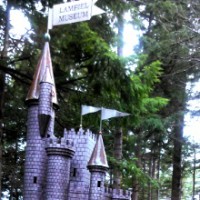
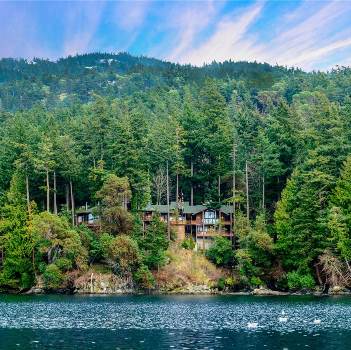
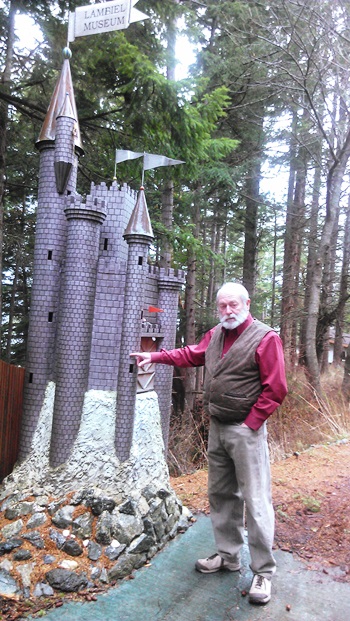
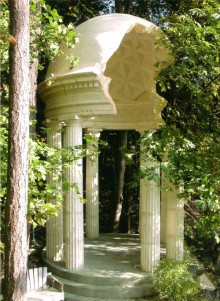
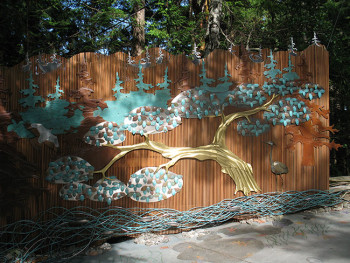







This was one of the most inspiring experiences in my life traveling the world. Orcas Islanders, please don’t let your indifference and island bureaucracy crush such rare devotion to your island’s art and spirit of authenticity. Support one of your own.
It is a special place and a special experience…. a very Orcas experience. I also hope it is supported by the public…….and residents. It is quite a tribute to the artistic people who call this area home.
For the record…when the article mentions “the fanciful 12-foot mailbox created by Todd Spalti”… Todd fabricated the mailbox to the design created by Fred Klein, a now-retired, recovering architect.